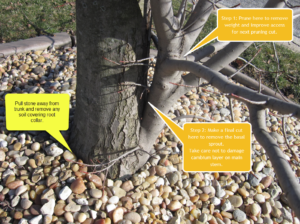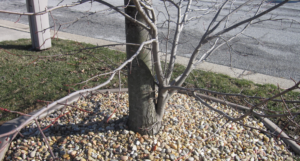Q. I have a maple tree (it is either an ‘October Glory’ or ‘Autumn Blaze’) that has (what I assume to be) a rather large sucker at the bottom. The diameter of the sucker is about 2 inches, and the tree trunk is 7 inches in diameter. I have attached pictures of it from different angles. I would like to know if it is OK to remove it? I’ve read quite a bit about these and that late winter/early spring is a good time to remove them. – J.M., Crown Point, Indiana
A. Some landscape plants produce vigorous, upright stems that become troublesome, because they out-compete better-formed branches and shade out the rest of the plant. These remarkably fast-growing, upright stems are called “suckers” if they come from the root system.

Remove the top of the sucker before making your final cut at the base of the tree
Photo Credit:Photo from J.M., Crown Point, Indiana; instructions by Lindsey Purcell.
You are correct that the best time to try removing these suckers is late winter and early spring before the new growth begins. You’ll want to be careful to avoid injuring the main trunk when you cut. First, remove the top of the root sucker (this can be done in stages) to get the heavy weight off that stem. Then, make closer cuts further down to just above where you see the “V.”
We also recommend that you pull the rock mulch away from the base of the tree and, if needed, remove any soil that is covering the root collar (the flare of the trunk at the bottom.) You can see an illustration of these recommendations on the annotated photo, courtesy of Purdue Urban Forestry Specialist Lindsey Purcell.
For more information, see Pruning Ornamental Trees and Shrubs
Q. I have several White Pine trees and have noticed some have been turning yellow since last summer. I’ve noticed that many throughout my area have the same yellowing. Is there something I can do to save them? – P.S., Jay County
A. Sadly, it is common for white pine to be in a state of decline in Indiana. They are beautiful trees but unfortunately, they are susceptible to stresses including droughts and floods, high and low temperatures, exposure to road salt, insects, and infectious diseases.
It is important to distinguish between normal fall needle drop and overall tree decline. White pine trees naturally shed their two-year-old needles in the fall, and this shed appears to happen suddenly and all at once. But the rest of the needles on the tree should be a good green color. If all or most of the needles on the tree are yellow, then the tree is most likely in a state of decline.
Reducing stress can help prevent, or at least slow, the onset of decline. But in many cases, this will be impractical and the site may not be appropriate for white pine. For more information, see Tree Diseases: White Pine Decline in Indiana (Purdue Extension publication BP-34-W).
